BUFFALO 09102067-1 AirStation Wireless-N NFINITI Keychain USB2.0 Adapter User Manual Manual
BUFFALO INC. AirStation Wireless-N NFINITI Keychain USB2.0 Adapter Manual
BUFFALO >
Manual
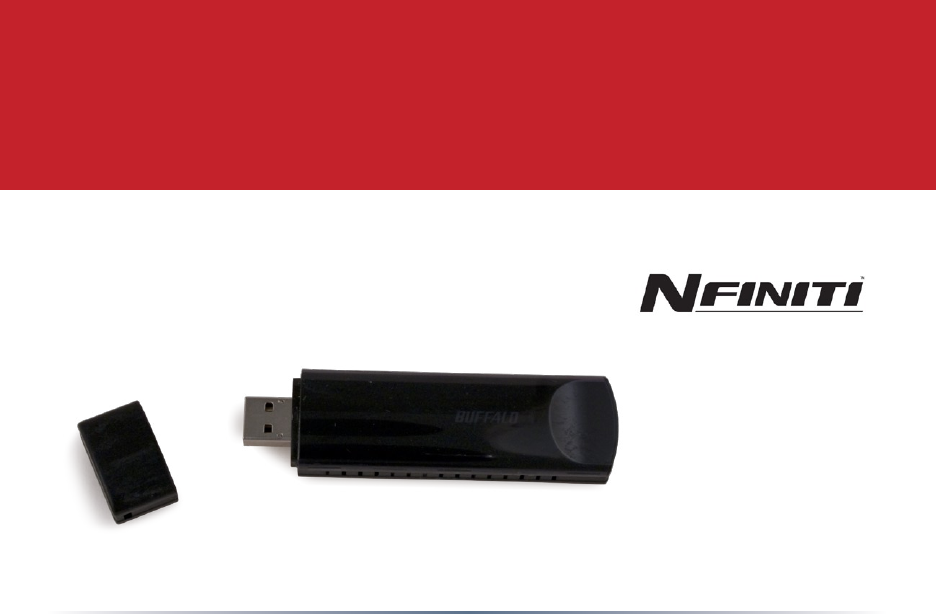
User Manual
AirStation Nniti
Draft-N Wireless USB Adapter
WLI-UC-G300N/WLI-UC-G300N-V1
v3.0
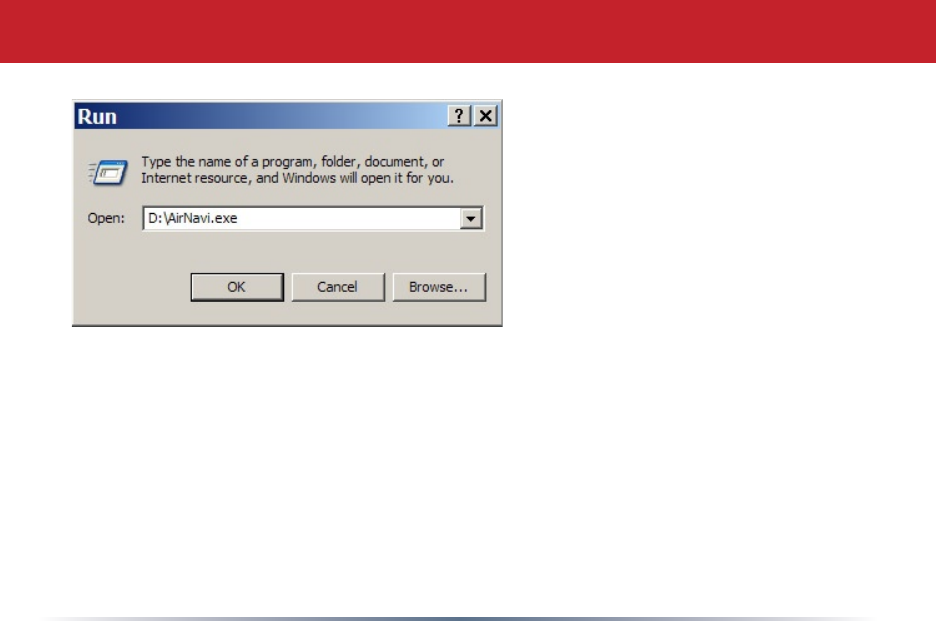
2
• Don’t plug in your wireless USB
client yet! Install the drivers
rst.
• Insert the AirNavigator CD
into the CD-ROM drive of your
computer. The AirNavigator
Setup Wizard should launch
automatically.
• To launch the AirNavigator
Setup Wizard manually, click
Start, then Run. Type “D:\
AirNavi.exe”, where D is the
drive letter assigned to your
CDrom.
• Click OK to launch the wizard.
Getting Started
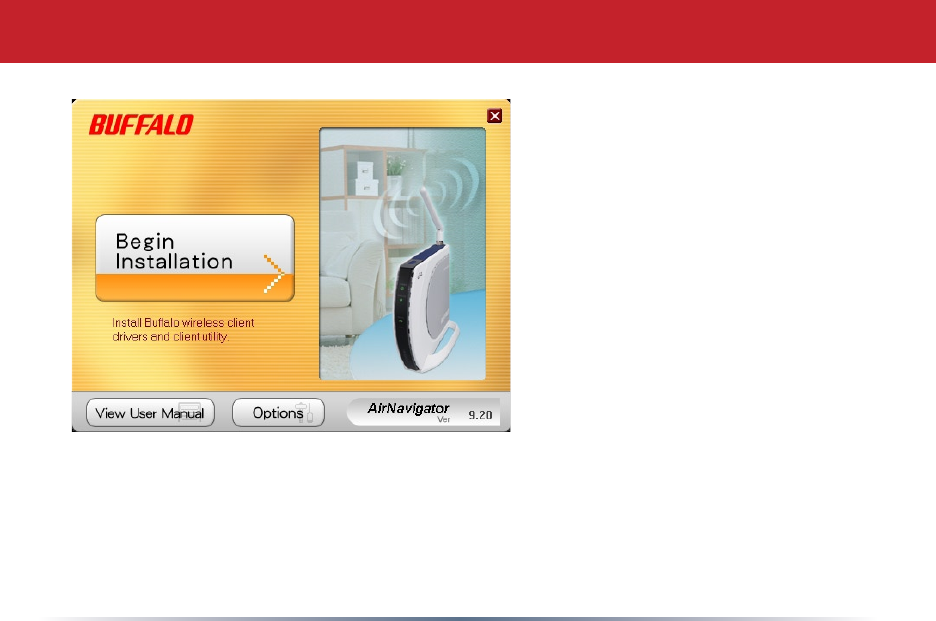
3
• Click on Begin Installation.
Installing Drivers
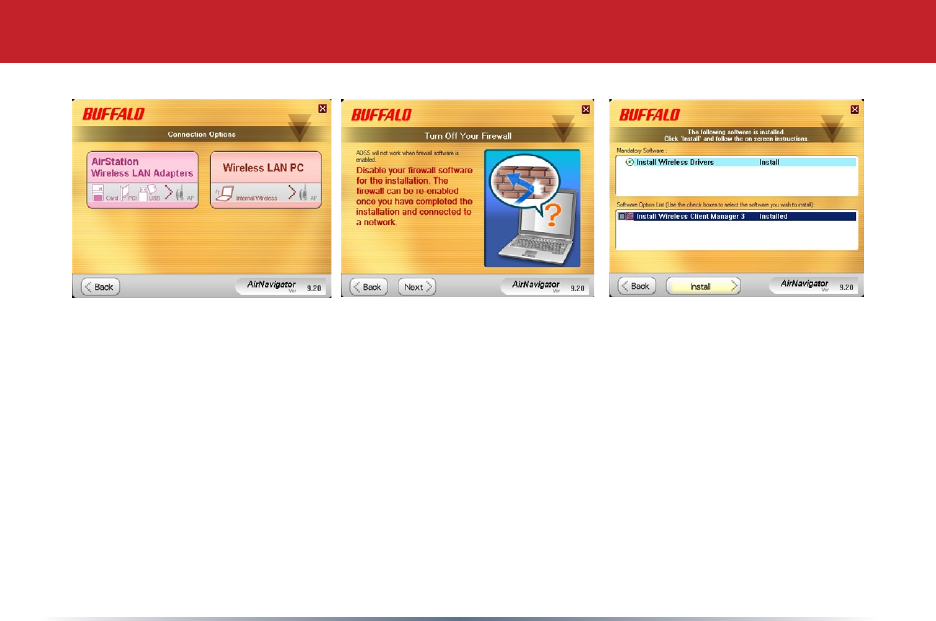
4
• Click AirStation Wireless LAN Adapters.
• If you are running a software firewall, disable it. Click Next.
• Installation of the Buffalo Wireless Client Manager is optional. Check Install Wireless
Client Manager to install it now. You can install it later if desired; see page 6.
• Click Install.
Installing Drivers
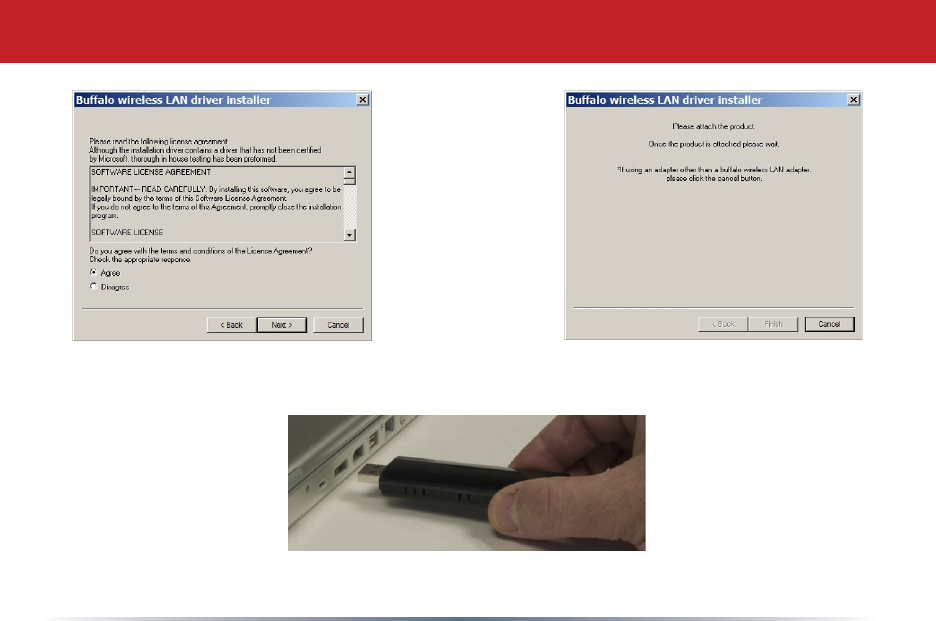
5
• Review the license agreement. Select Agree and click Next to continue installation.
• Plug your AirStation Nfiniti into a USB port on your computer.
• When the Wireless USB Adapter is successfully installed, click Finish. If you’re not
installing Client Manager, turn to page 11.
Installing Drivers
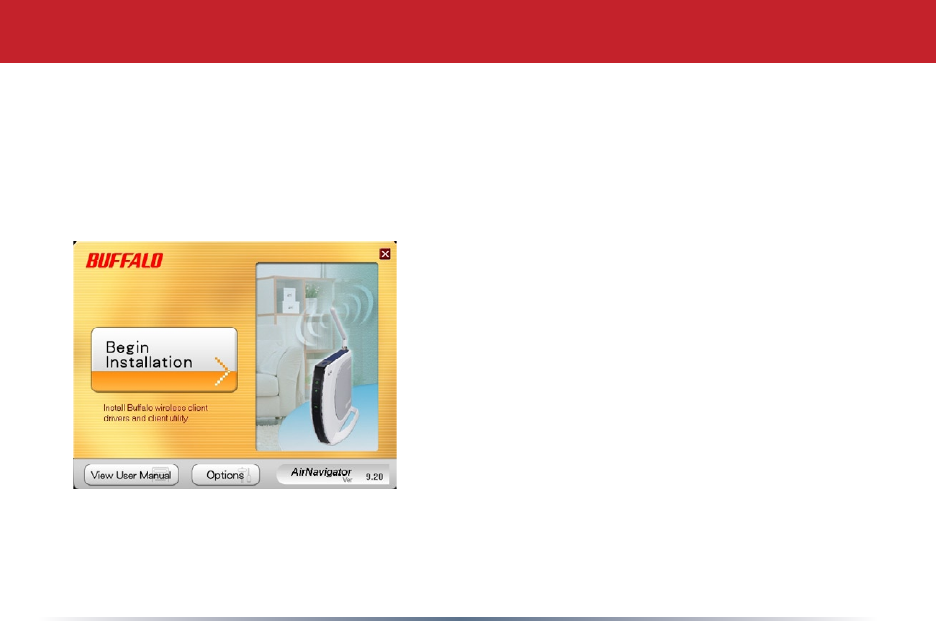
6
Client Manager can be used to survey and connect to available access points, congure
WPA/WEP encryption, and create connection proles.
Note: When the Buffalo Client Manager is installed, the client manager built-in to
Windows is automatically disabled.
Installing Client Manager
If you didn’t check the Client Manager
install box on page 4, you’ll have to rerun
installation to install Client Manager.
Insert the AirNavigator CD into the CD-
ROM drive of you computer. If the Air
Navigator Setup Wizard does not launch
automatically, launch it manually by
clicking Start and then Run. Enter D:\
AirNavi.exe in the dialog box that appears.
Click OK. Select Begin Installation.
Client Manager
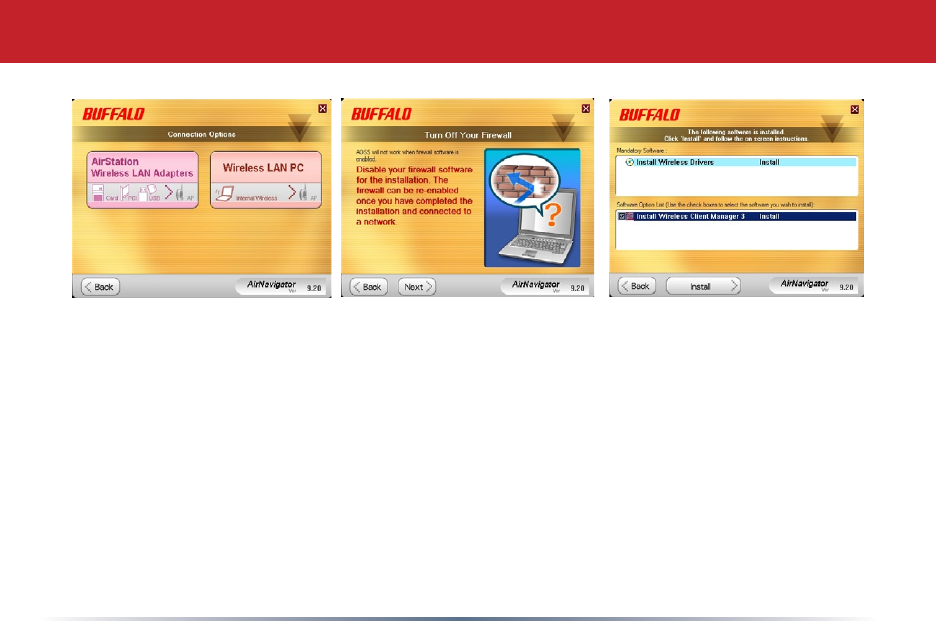
7
Client Manager
• Click AirStation Wireless LAN Adapters.
• If you are running a software firewall, disable it. Click Next.
• Put a check next to Install Wireless Client Manager.
• Click Install.
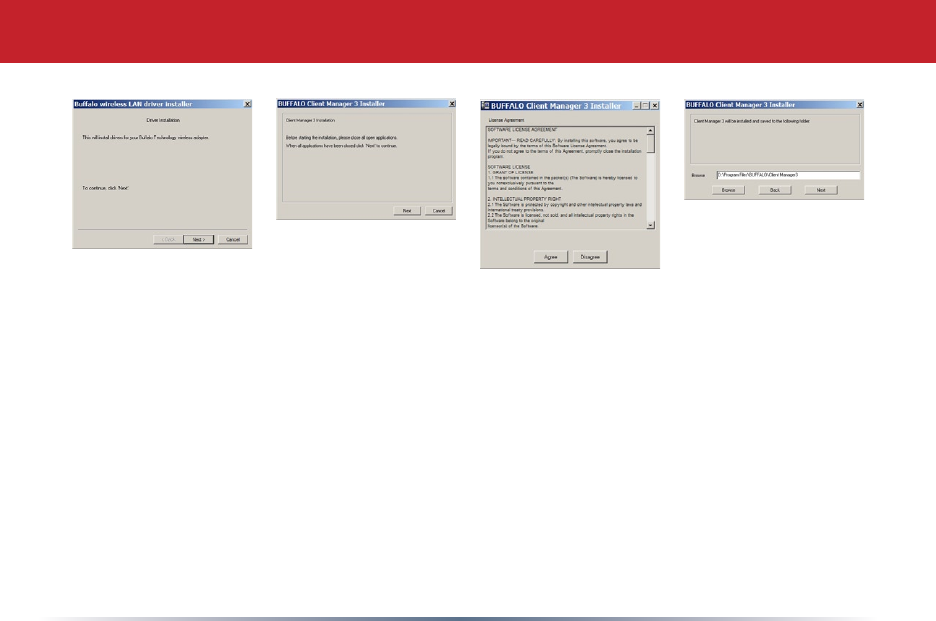
8
Client Manager
• Driver installation will begin. If you’ve already installed drivers, click Cancel.
• Client Manager installation will begin. Click Next.
• Click Agree.
• Click Next.
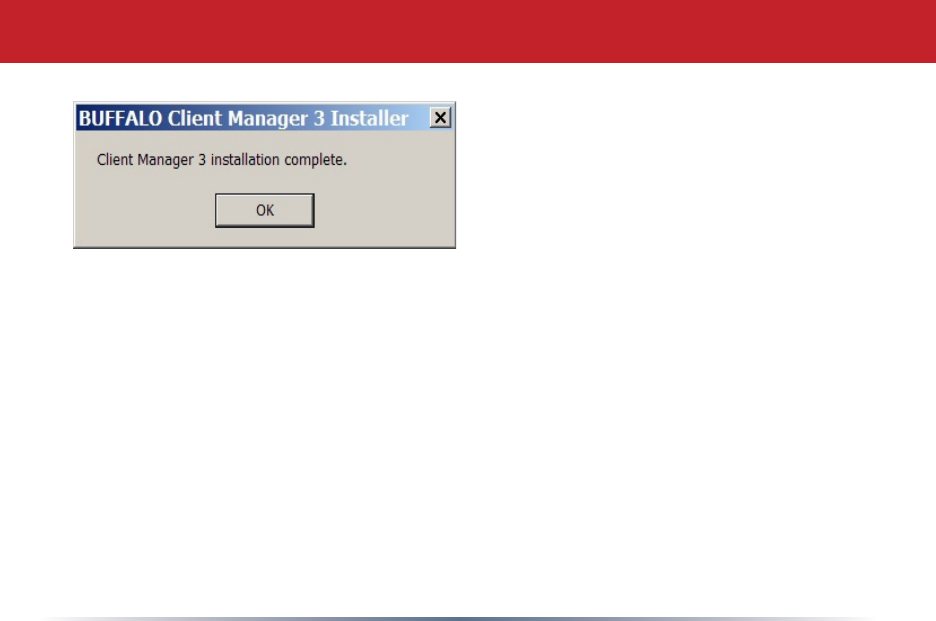
9
Client Manager
• Click OK when Client Manager
installation is complete.
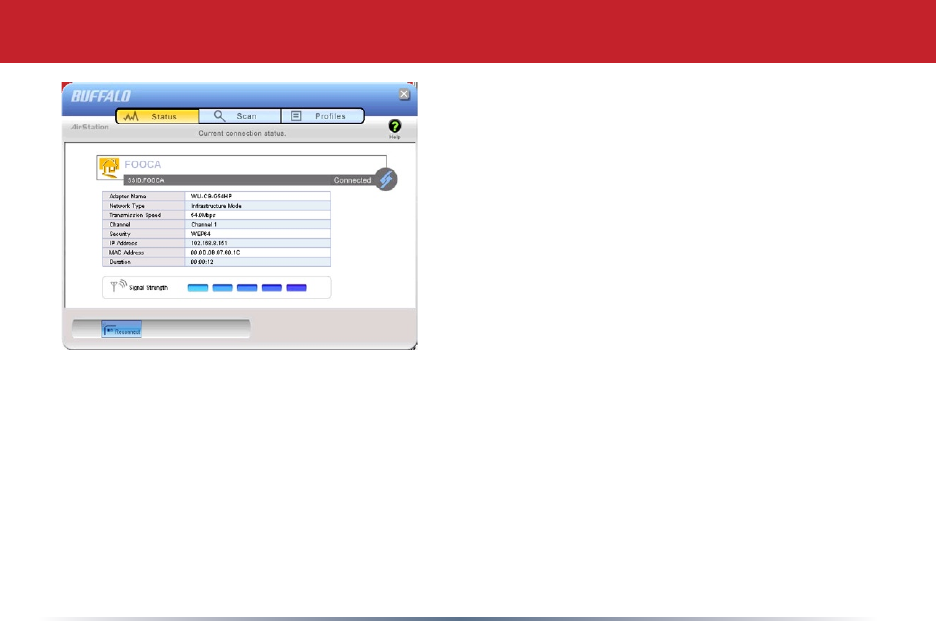
10
Connecting Wireless Clients to your Network
Buffalo supports three different
methods for connecting your wireless
client device to your network.
If your AP supports it, use the simple,
utterly secure AOSS to connect.
Install the Client Manager from your
AirNavigator CD (page 6) and turn to
page 12.
You may also use the Client Manager
software from your AirNavigator CD to
configure your network manually. See
page 15 for more on Client Manager.
If you’re running Windows XP or Vista
on your PC, you may use their built-in
wireless tools to connect to your router/
AP. See page 22 for more on XP or 26
for more on Vista.
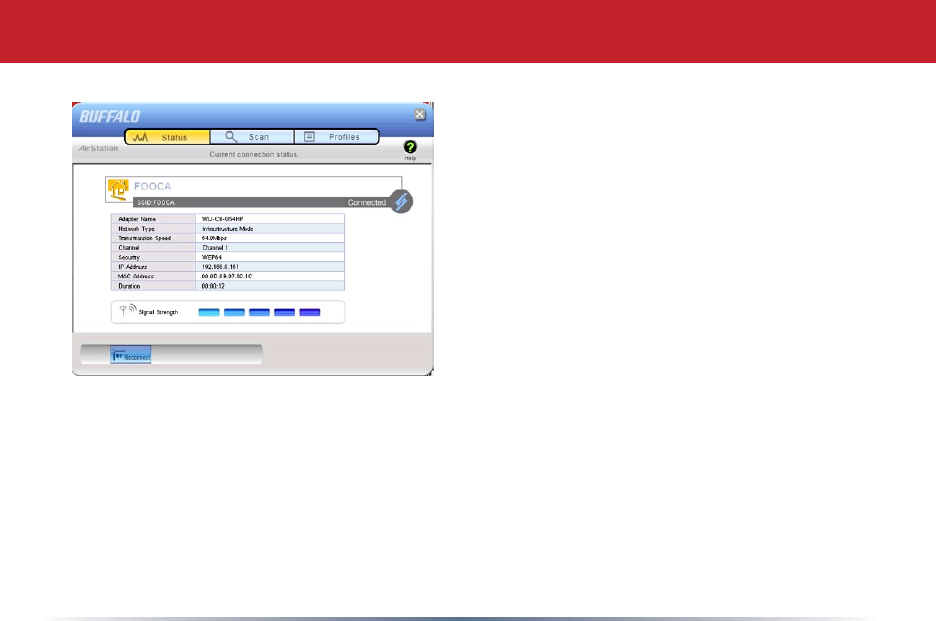
11
The AOSS button for this wireless client is in its Client Manager software. Start
Client Manager by right clicking on the black antenna icon in your System Tray,
or by launching the Client Manager from your Start Menu: Programs >> Buffalo
>>AirStation Utility >> Client Manager.
AOSS (AirStation One-Touch Secure
System) is a simple, one-touch setup for
connecting wireless clients to an access
point while enforcing the most secure
possible connection encryption type.
Users no longer need to worry about
choosing the proper security protocols,
IP addresses, or SSID. AOSS determines
the optimal connection and congures
itself in seconds. If your router doesn’t
support AOSS, turn to page 6 to
congure your connection manually with
Client Manager or Wireless Zero Cong.
Using AOSS
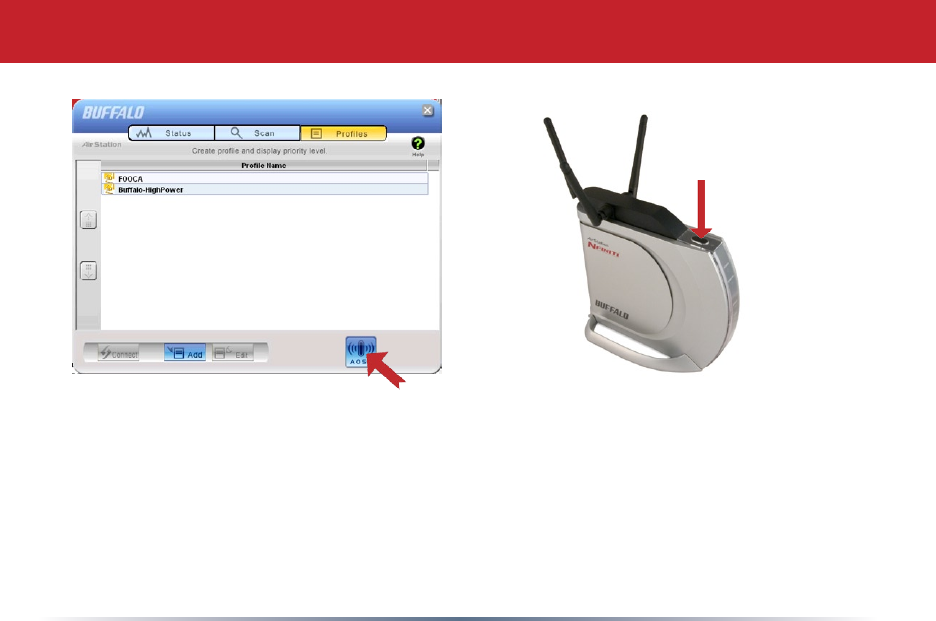
12
• From the Status Screen, select the Proles tab.
• Click the blue AOSS button on the Client Manager’s screen. The AOSS wizard will
appear.
• Now, press the AOSS button on the Access Point. Hold it down until the AOSS LED
begins to ash.
Using AOSS
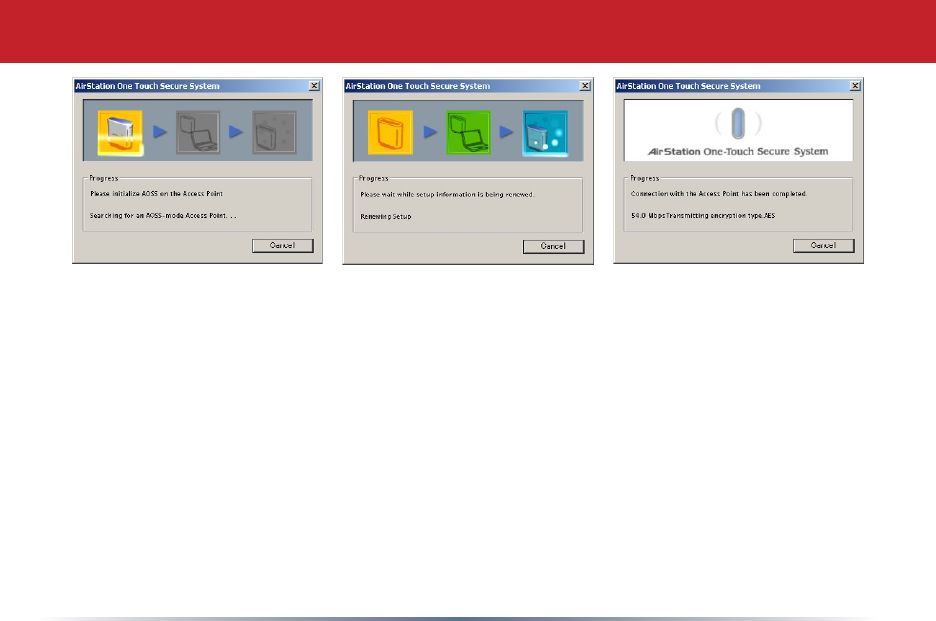
13
Once AOSS is complete (about 30 seconds), the connection is archived as a prole for later
use. To minimize Client Manager to the system tray, click the ‘X’ in the top right corner.
Notes:
AOSS will scan for an AOSS partner for about two minutes. If it times out before nding
one, just press the AOSS buttons again.
Output power is reduced to 25% of normal during AOSS for security reasons. If you’re
having trouble making an AOSS connection, temporarily move the devices closer together.
AOSS will automatically use the highest level of security available for all currently
connected wireless devices.
If you have trouble connecting with AOSS, temporarily disable all personal rewalls on
your PC, such as ZoneAlarm or Microsoft Personal Firewall. These programs may be re-
enabled after AOSS has nished.
Using AOSS
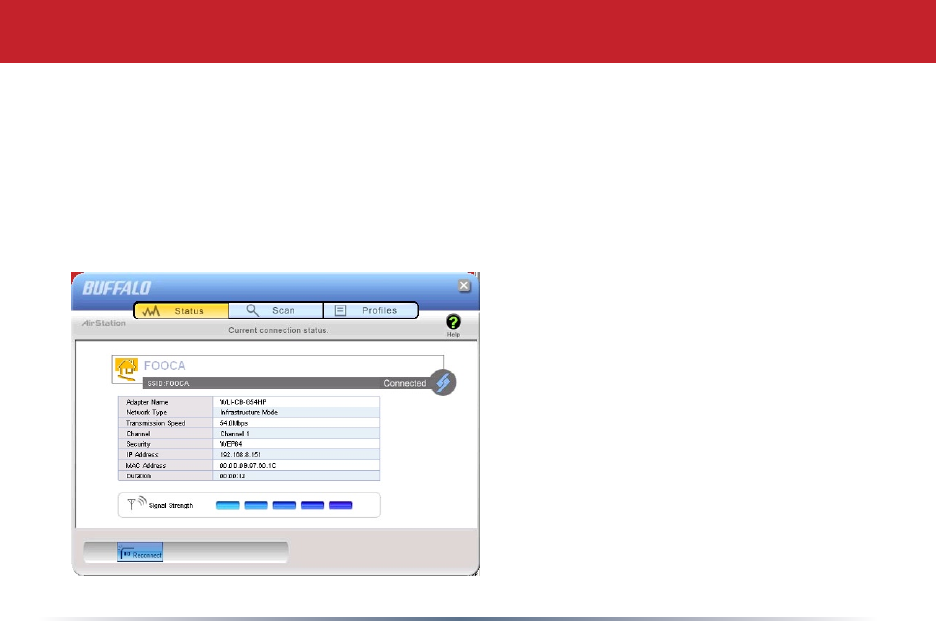
14
You may use Client Manager to congure your wireless network. Client Manager consists
of the Status page, the Survey page, and the Proles page. You can access each page by
clicking the corresponding button on Client Manager. In addition to these pages, several
dialog boxes are also available. You can access the Edit Prole dialog box, New Prole
dialog box, IP Conguration dialog box, or WEP Conguration dialog box using the Client
Manager pages. You may also initiate AOSS.
Status Page
Click Status to open this page. By
default, this page is displayed when
you start Client Manager. Details of
connection status are displayed.
This page only displays connection
information; no changes to settings are
made here.
This page includes the following
components:
• Adapter Name – Displays the part
number of the wireless adaptor that is
being used.
Client Manager Conguration

15
Client Manager Conguration
• Network Type - Displays whether network is in Ad-Hoc or Infrastructure mode.
• Rate – The speed of communication between wireless devices. If the Client Manager is
not connected to a remote wireless device (access point or another client), no rate will
be displayed.
• Channel – The channel that the two wireless clients are using for communication. If
the Client Manager is not connected to a remote wireless device, no channel will be
displayed. Channels 1-11 may be used.
• Security – The type of encryption in use. If the Client Manager is not connected to a
remote wireless device, then ‘No Encryption’ will be displayed.
• IP Address – The IP address of the machine the Client Manager is installed on. If the
Client Manager is not connected to a network with DHCP, then no IP address will be
displayed.
• MAC Address – The MAC address of the wireless client device inside the computer
Client Manager is installed on. If no wireless device is present in the computer, then no
MAC Address will be displayed.
• Signal Strength – Displays the signal strength of the peak signal level the wireless
adapter receives from the wireless device to which it is connected. Next to the signal
level is the wireless hardware being used for this measurement.
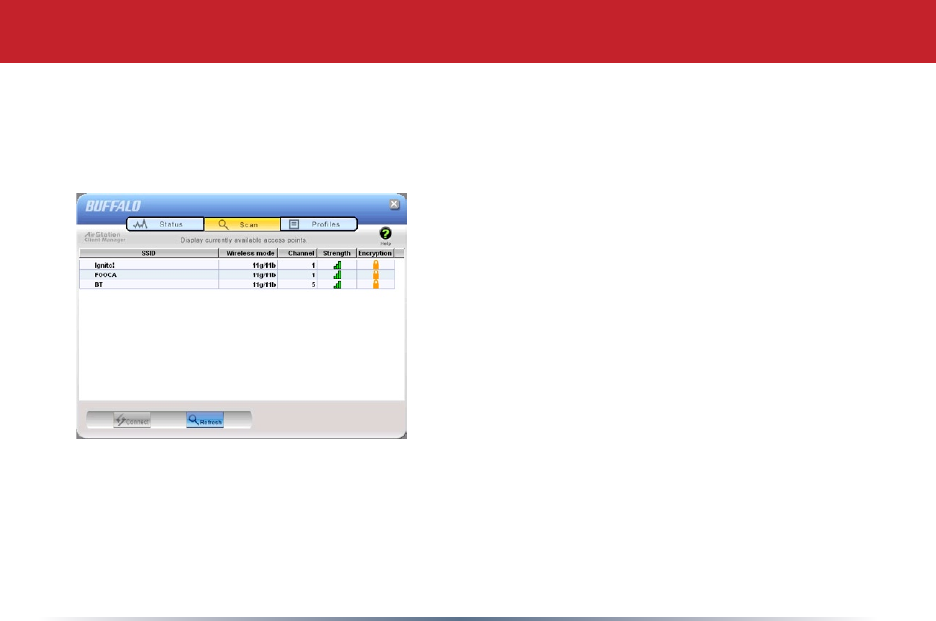
16
Click the Scan tab to open this page. Here, you can survey the area, display available
access points, and connect to available access points.
This page includes the following components:
• Wireless SSID – The SSID is the “name” of
a wireless network. Each wireless device
on a network must use identical SSIDs to
successfully communicate.
• Wireless Mode – Displays available modes for
each available remote wireless device.
• Strength – Displays the relative signal strength of
the wireless networks.
• Encryption – Displays whether the wireless
network is using any sort of encryption.
Click Connect to connect to a highlighted SSID,
or Refresh to update the list of available wireless
devices.
Client Manager Conguration
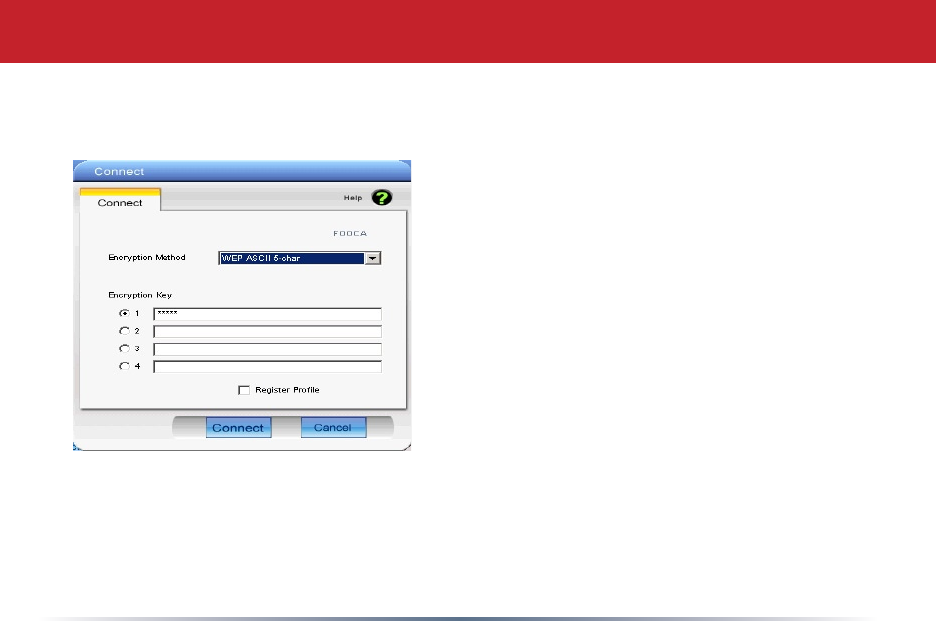
17
This dialog will open for you to enter any necessary encryption information.
The correct encryption type should already be
selected automatically in the Encryption Method
drop down list. Only change this setting if
necessary.
The Encryption Key is where the actual key for
the wireless network should be entered. Some
wireless networks allow you to enter multiple
keys; four separate elds are available for this. If
your network only uses one encryption key, then
please use the rst eld (#1) to enter your key.
The Register Prole option will store this
wireless network in your proles. You will then
automatically connect to this network when
inside its range. This is recommended if you plan
on using this wireless network again.
Press the Connect button once you have completed entering encryption information.
Client Manager Conguration
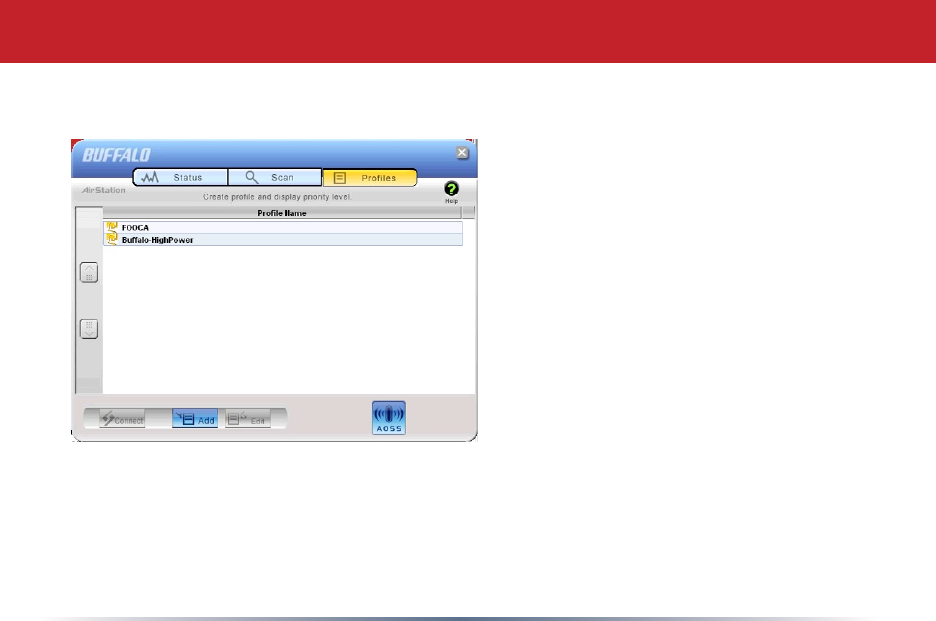
18
Proles Page
Click the Proles tab to open this page.
Use this page to access your proles.
Proles allow you to save the information
associated with a specic wireless
network so you can quickly and easily
connect to that network when you are in
that location. The Proles page allows you
to add, delete, and edit your proles, as
well as import and export data.
• Connect – Click the Connect button
to connect to the selected prole and
return to the Status page.
• Edit – Click the Edit button to edit the
selected prole’s settings. The Edit
button also allows you to delete proles
that are no longer used or required.
• Add – Click the Add button to add a prole manually. You will need important
information such as SSID, encryption settings, and network type.
Client Manager Conguration
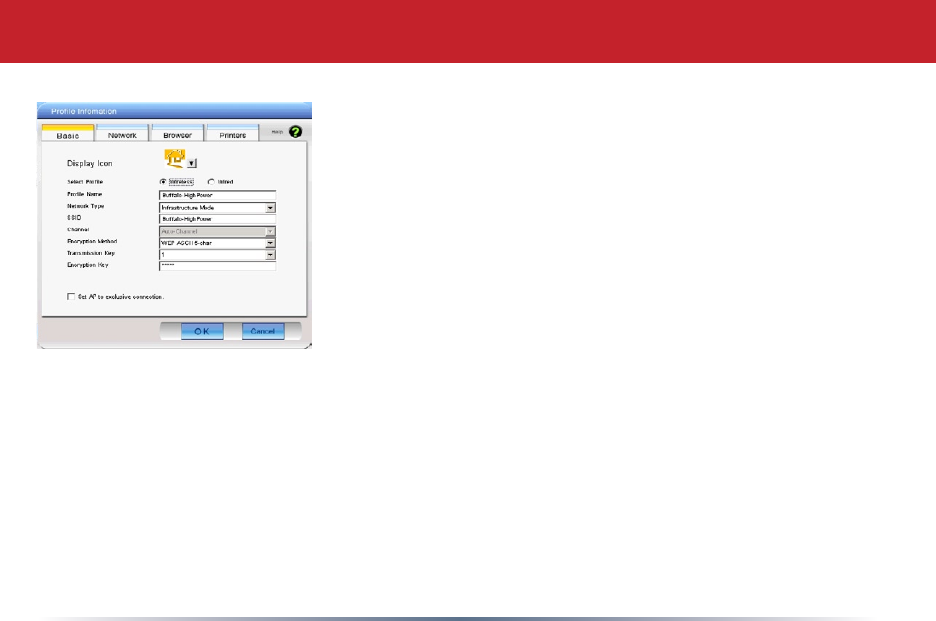
19
New Prole Dialog Box
• Select Prole – Select whether the prole is for a wireless or
wired connection.
• Prole Name – Enter the name you want to associate with
the new prole.
• Network Type – Select the network mode you want to
associate with the new prole. Select Infrastructure if your
network consists of both wired and wireless devices that
communicate through a central device, such as an access
point. Select Ad-hoc if your network consists of only wireless
devices that communicate with each other directly.
• Network Name SSID – Enter the SSID of your network. The
SSID is the name of your wireless network. All wireless
devices on a network must use identical SSIDs to successfully associate with other devices on
the network. MYSSID is an example of a valid SSID.
• Channel – The channel setting is only used for Ad-hoc connections. When using an Ad-hoc
connection, select a channel and make sure the other Ad-hoc devices are congured to use the
same channel. Otherwise, use Auto-Channel.
• Encryption Method – Displays the types of encryption available. Once encryption is selected,
you will be required to enter an Encryption Key. For the Transmission Key Number, 1 is
recommended.
• OK – Click OK to save your specications and return to the Proles page.
Client Manager Conguration

20
Advanced Prole Options
• Network Tab – Displays the network information tab. A static IP can be specied for
this wireless prole here. It is not recommended to change any of these settings unless
specied by an administrator.
• Browser Tab – Displays settings to change your browser preferences for this wireless
prole. A specic home page can be specied when connected to this wireless prole as
can specic proxy server addresses.
• Printers Tab – Displays the printers tab. A specic default printer can be associated to
this prole. Thus, when connected to this prole, a specic printer will be used as the
default printer.
• OK – Click the OK button to save your specications and return to the Proles page.
• AOSS Icon – To automatically add the USB wireless client to your network,
just click this icon and then hold down the AOSS button on your wireless
router for a few seconds.
Check your package for an AOSS Manual, which will give more information
on using AOSS.
Client Manager Conguration
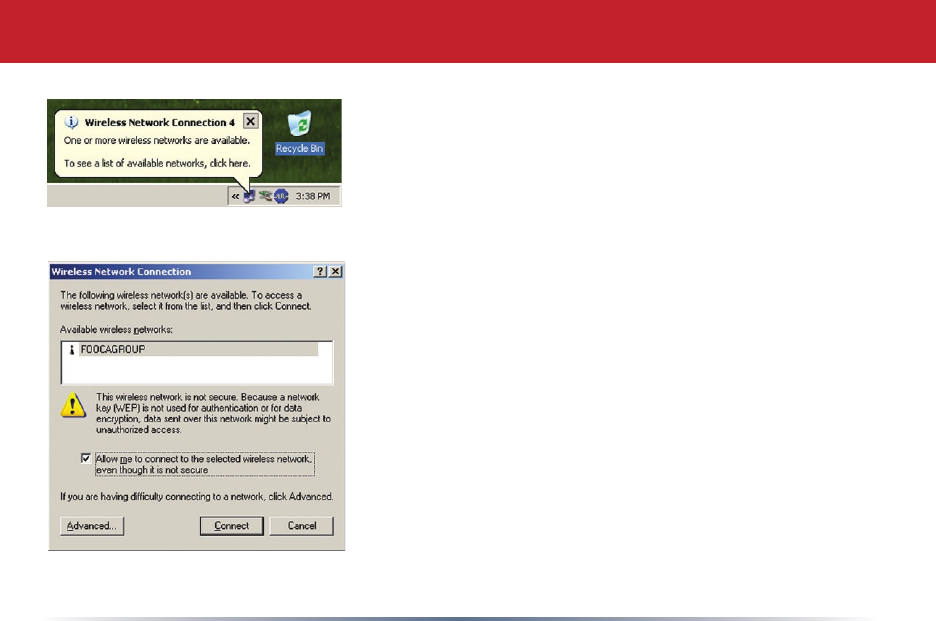
21
Windows XP includes the Zero Conguration Service, a
built in service to congure your wireless clients from
within Windows. Turn to page 6 if you would rather use
Buffalo’s Client Manager to congure your wireless client.
• If the Wireless Zero Configuration Service is activated,
Windows will scan for available wireless access points
once the Wireless USB Adapter is properly installed.
If Windows detects one or more access points, a
networking icon appears within the system tray. “One
or more wireless networks are available” will appear as
a caption accompanying the icon.
• To start Wireless Zero Configuration manually, click
Start >> Control Panel >> Administrative Tools >>
Services. Select Automatic in the Startup Type field of
Wireless Zero Configuration Service.
• Right click the networking icon in the taskbar and
select View Available Wireless Networks. Select an
SSID and click Connect. You may need to check the
box indicating you are connecting to an unsecured
network. See page 23 if you need to enter an SSID
network name or WEP/WPA encryption key.
Zero Conguration Service
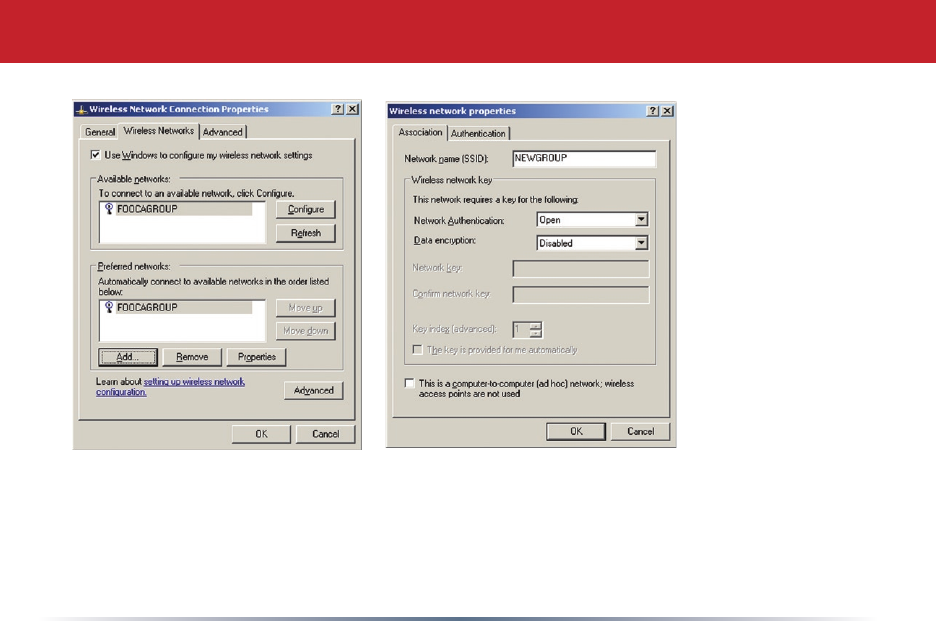
22
• Click the Advanced tab to enter an SSID network name or WEP/WPA encryption key if
necessary. To add an SSID network name that is not listed, click Add.
Zero Conguration Service
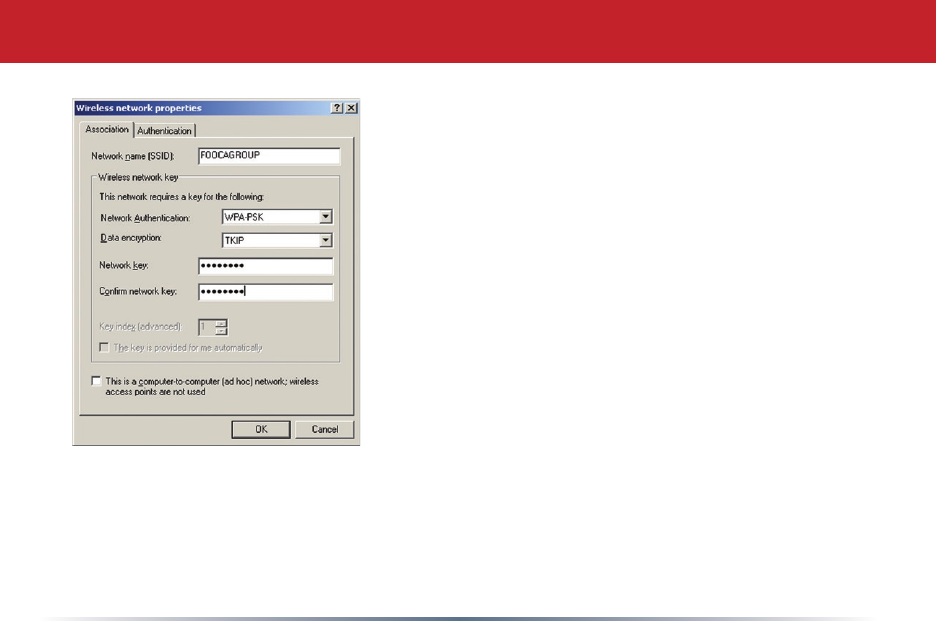
23
• To congure a WEP/WPA encryption key, select the
wireless network and click Congure.
• From the pull down menu, select the Network
Authentication and Data Encryption types for the
wireless network. Enter and conrm the Network
Key and Key Index. Click OK when nished.
Zero Conguration Service

24
Wireless Zero Conguration
Wireless Zero Conguration Service (Windows XP)
Windows XP offers the Wireless Zero Conguration Service to support 802.11b and
802.11g wireless networking. This service automatically polls the area for available
wireless access points. If an available wireless access point is found, Windows attempts
to connect to the access point. If no available wireless access points are found, you must
manually add the access point information to connect (for example when the SSID is not
broadcasted).
Note: The Wireless Zero Conguration Service and Client Manager do not function
properly together. If you want to use Client Manager, disable the Wireless Zero
Conguration Service.
Enabling the Wireless Zero Conguration Service
Click Start >> Control Panel >> Administrative Tools >> Services to open the Services
conguration window. Select Automatic in the Startup Type eld of Wireless Zero
Conguration Service to enable the Wireless Zero Conguration Service and click apply.
Note: The default Startup Type value of Wireless Zero Conguration Service is Automatic.
Disabling the Wireless Zero Conguration Service
Click Start >> Control Panel >> Administrative Tools >> Services to open the Services
conguration window. Select Disabled in the Startup Type eld of Wireless Zero
Conguration Service to disable the Wireless Zero Conguration Service.
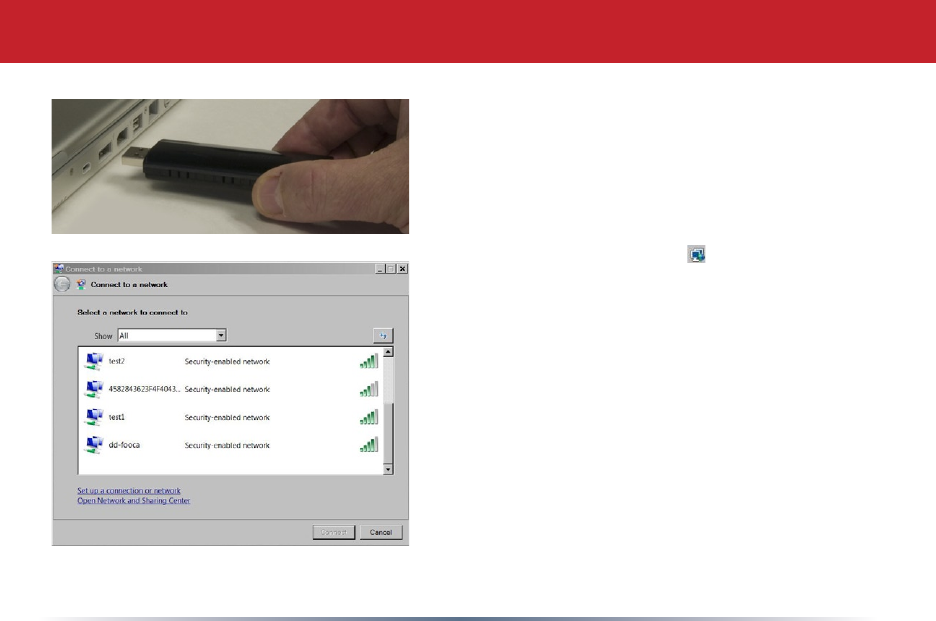
25
Windows Vista also includes a built in wireless
client manager. You may use it to congure your
Buffalo wireless client, or turn to page 6 if you
would rather use Buffalo’s Client Manager to
congure your wireless client.
• Plug in your USB wireless client.
• Click on the Network icon in the systray.
• A list of available wireless networks will appear.
Choose your desired wireless network’s SSID.
Windows Vista
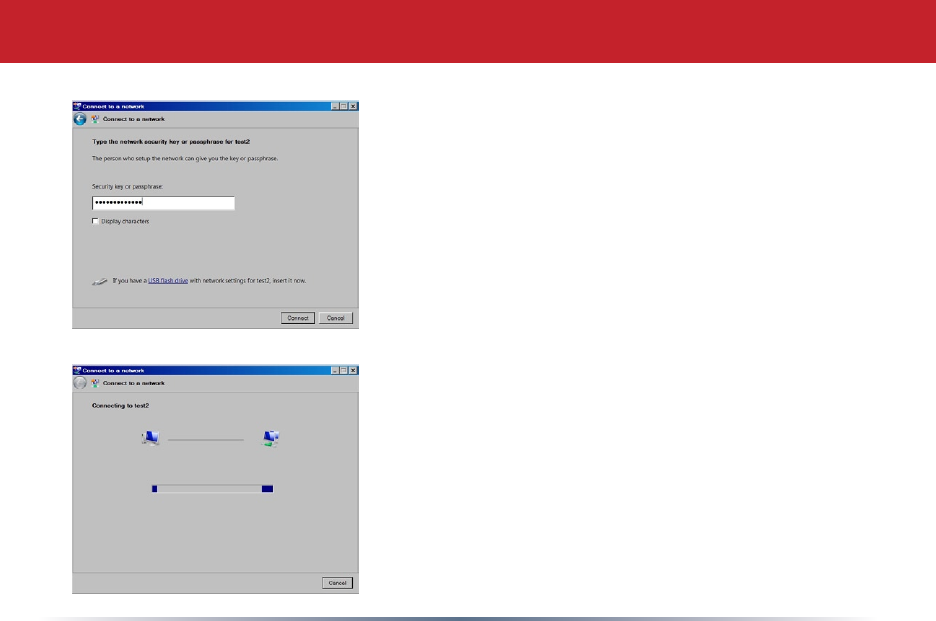
26
• If your chosen wireless network is security enabled,
enter the network security key or password.
• Windows will now connect you to your wireless
network.
Windows Vista
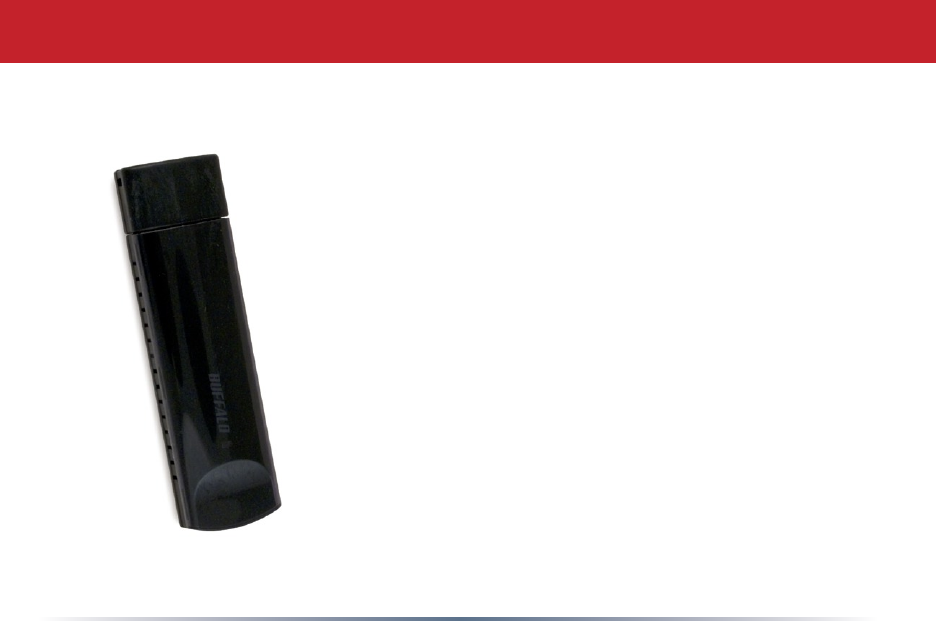
27
Antenna Information
The WLI-UC-G300N has two built-in antennas. External
antennas cannot be attached to the WLI-UC-G300N.

28
Specications
Wireless LAN Interface
Standards Compliance Draft-N (802.11n Draft Specication 1.0)
IEEE 802.11g
IEEE 802.11b
Communication Protocol Direct Sequence Spread Spectrum (DSSS)
Orthogonal Frequency Division Multiplexing
Frequency Range 2.412 - 2.462 Ghz
Transmission Rate Draft-N: Up to 300 Mbps (Auto)
802.11g: 6, 9, 12, 18, 24, 36, 48, 54 Mbps (Auto)
802.11b: 1, 2, 5.5, 11 Mbps (Auto)
Access Mode Infrastructure Mode
Security 128/64 Bit WEP, WPA-PSK (TKIP & AES),
WPA2-PSK (TKIP & AES))
Other
Interface USB 2.0
Environmental Operation 32º - 113º Fahrenheit (0º - 45º Celsius)
Relative Humidity 20 - 80 % (non-condensing)

29
Troubleshooting / FAQ
What should I do if I already have a version of Client Manager on my PC?
Update your Client Manager to the version on the CD. If you do not update your Client
Manager, there could be a loss of functionally, as some older versions of Client Manager
will not work properly with the G300N Wireless Notebook Adapter. Before updating
Client Manager, uninstall any previous versions of Client Manager. To update your Client
Manager, load the Air Navigator CD and select Install Client Manager. Proles can rst
be exported from the Proles tab of Client Manager and then imported back into Client
Manager after installation.
Why won't Client Manager function properly?
The Wireless Zero Conguration Service in Windows XP conicts with Client Manager. If
you use Windows XP, make sure that the Wireless Zero Conguration Service is disabled.
Click Start >> Control Panel >> Administrative Tools >> Services. Select Disabled in
the Startup Type eld of Wireless Zero Conguration Service to enable the Wireless
Zero Conguration Service. The default value of Wireless Zero Conguration Service is
Automatic.
I have more than one Air Navigator CD. Do I need more than one CD?
No. The same Air Navigator CD works with all Buffalo Technology access points and
wireless adapters. Please use the newest CD you have, with the highest revision number
on it.

30
10BaseT or 100BaseTX: 802.3 based Eth-
ernet network that uses UTP (Unshielded
twisted pair) cable and a star topology. 10
is 10 Mbps and 100 is 100 Mbps.
802.1x: The standard for wireless LAN
authentication used between an AP and a
client. 802.1x with EAP will initiate key
handling.
Ad-Hoc Network: The wireless network
based on a peer-to-peer communications
session. Also referred to as Adhoc.
Bandwidth: The transmission capacity of
a computer or a communication channel,
stated in Megabits per second (Mbps).
BSS (Basic Service Set): An 802.11 net-
working framework that includes an Access
Point.
Bus Mastering: A system in which the spec-
ied Input/Output device (e.g. NIC Card)
can perform tasks without the intervention
of the CPU.
Client: A PC or workstation on a network.
Cross-Over Wiring: A UTP cable that has its
transmit and receive pair crossed to allow
communications between two devices.
DCE (Data Communications Equipment):
Hardware used for communication with a
Data Terminal Equipment (DTE) device.
Default Gateway: The IP Address of either
the nearest router or server for the LAN.
Default Parameter: Parameter set by the
manufacturer.
Destination Address: The address portion of
a packet that identies the intended recipi-
ent station.
DHCP (Dynamic Host Conguration
Protocol): Based on BOOTP, it uses a pool
of IP addresses, which it assigns to each
device connected to it, and retrieves the
address when the device becomes dormant
for a period of time.
Glossary

31
DNS (Domain Name System): System used
to map readable machine names into IP
addresses
Driver: Software that interfaces a computer
with a specic hardware device.
DSSS (Direct Sequence Spread Spectrum):
Method of spreading a wireless signal into
wide frequency bandwidth.
DTE (Data Terminal Equipment): Device that
con10BaseT or 100BaseTx: 802.3 based
Ethernet network that uses UTP (Unshield-
ed twisted pair) cable and a star topology.
10 is 10 Mbps and 100 is 100 Mbps.
DCE (Data Communications Equipment):
Hardware used for communication with a
Data Terminal Equipment (DTE) device.
Default Gateway: The IP Address of either
the nearest router or server for the LAN.
Default Parameter: Parameter set by the
manufacturer.
Destination Address: The address portion
of a packet that identies the intended
recipient station.
DHCP (Dynamic Host Conguration
Protocol): Based on BOOTP, it uses a pool
of IP addresses, which it assigns to each
device connected to it, and retrieves the
address when the device becomes dormant
for a period of time.
DNS (Domain Name System): System used
to map readable machine names into IP
addresses
Driver: Software that interfaces a computer
with a specic hardware device.
DSSS (Direct Sequence Spread Spectrum):
Method of spreading a wireless signal into
wide frequency bandwidth.
DTE (Data Terminal Equipment): Device
that controls data owing to and from a
computer.
Glossary

32
Dynamic IP Address: An IP address that is
automatically assigned to a client station
in a TCP/IP network, typically by a DHCP
server.
ESS (Extended Service Set): A set of two or
more BSSs that form a single sub-network.
ESS-ID is user identication used in the
ESS LAN conguration.
Ethernet: The most widely used architecture
for Local Area Networks (LANs). It is
a shared-media network architecture.
The IEEE 802.3 standard details its
functionality.
Ethernet cable: A wire similar to telephone
cable that carries signals between Ethernet
devices.
File and Print Sharing: A Microsoft applica-
tion that allows computers on a network to
share les and printers.
Firmware: Programming inserted into
programmable read-only memory, thus
becoming a permanent part of a computing
device.
Frame: A xed block of data, transmitted as
a single entity. Also referred to as packet.
Full-Duplex: To transmit on the same
channel in both directions simultaneously.
Gbps (Giga Bits per second): One billion
bits per second.
Half-duplex: To transmit on the same
channel in both directions, one direction at
a time.
Hub: A device which allows connection
of computers and other devices to form a
LAN.
IEEE (Institute of Electrical and Electronics
Engineers): The professional organization
which promotes development of electronics
technology.
Glossary

33
MAC (Medium Access Control) Address: A
unique number that distinguishes network
cards.
Mbps (Mega Bits Per Second): A
measurement of millions of bits per
second.
MDI/X (Media Dependent Interface/Cross-
over): Port on a network hub or switch
that crosses the incoming transmit lines
with the outgoing receive lines.
MHz (MegaHertz): One million cycles per
second.
MIB II: A database containing performance
information and statistics on each device in
a network.
MIPS (Million Instructions Per Second): A
measurement of processing speed.
NAT (Network Address Translation): An
internet standard that enables a LAN to
use one set of IP addresses for internal
trafc and a second set for external trafc.
IP (Internet Protocol) Address: A unique
32-binary-digit number that identies each
sender or receiver of information sent in
packets.
Infrastructure: A wireless network or
other small network in which the wireless
network devices are made a part of the
network through the Access Point.
ISP (Internet Service Provider): A company
that provides access to the Internet and
other related services.
IV (Initialization Vector): The header section
of a message packet.
LAN (Local Area Network): A group of com-
puters and peripheral devices connected to
share resources.
LED (Light Emitting Diode): The lights on a
hardware device representing the activity
through the ports.
Glossary

34
NIC (Network Interface Card): An
expansion card connected to a computer
so the computer can be connected to a
network.
Packet: A block of data that is transferred
as a single unit, also called a frame or a
block.
Packet Filtering: Discarding unwanted
network trafc based on its originating
address or its type.
PCI (Peripheral Component Interconnect):
A bus that is connected directly to the
CPU.
PCMCIA (Personal Computer Memory Card
International Association) Card: Removable
module that adds features to a portable
computer.
Ping (Packet Internet Groper): An Internet
utility used to determine whether a
particular IP address is online.
Plug and Play: Hardware that, once
installed (“plugged in”), can immediately
be used (“played”), as opposed to hardware
that requires manual conguration.
PoE (Power over Ethernet): A mechanism
to send DC power to a device using a CAT5
Ethernet cable.
PPPoE (Point-to-Point Protocol over
Ethernet): A specication for connecting
users on an Ethernet line to the Internet
through a common broadband medium.
Protocol: A standard way of exchanging
information between computers.
RADIUS (Remote Authentication Dial
In User Service): A server that issues
authentication key to clients.
RAM (Random Access Memory): Non-
permanent memory.
Glossary

35
Repeater Hub: A device that collects,
strengthens and transmits information to
all connected devices, allowing the network
to be extended to accommodate additional
workstations.
RC4: The encryption algorithm that is used
in WEP.
RJ-45 connector: An 8-pin connector used
between a twisted pair cable and a data
transmission device.
ROM (Read Only Memory): Permanent
memory.
Router: Device that can connect individual
LANs and remote sites to a server.
Roaming: The ability to use a wireless
device while moving from one access point
to another without losing the connection.
Script: A macro or batch le containing
instructions and used by a computer to
perform a task.
Server: Any computer that makes les or
peripheral devices available to users of the
network and has a resident Network OS.
SMTP (Simple Mail Transfer Protocol):
The protocol used to dene and deliver
electronic mail (E-mail) from one location
to another.
SNMP (Simple Network Management
Protocol: An application layer protocol
that outlines the formal structure for
communication among network devices.
Static IP Address: A permanent IP address
is assigned to a node in a TCP/IP network.
Also known as global IP.
STP (Shielded Twisted Pair): Twisted Pair
cable wrapped in a metal sheath to provide
extra protection from external interfering
signals.
Subnet Mask: An eight-byte address
divided into 4 parts separated by periods.
Glossary

36
TCP/IP (Transmission Control Protocol/
Internet Protocol: Protocol used by
computers when communicating across
the Internet or Intranet.
TFTP (Trivial File Transfer Protocol): Simple
form of FTP (File Transfer Protocol), which
Uses UDP (User Datagram Protocol),
rather than TCP/IP for data transport and
provides no security features.
TKIP (Temporal Key Integrity Protocol):
An encryption method replacing WEP.
TKIP uses random IV and frequent key
exchanges.
Topology: The shape of a LAN (Local Area
Network) or other communications system.
Twisted Pair: Cable that comprises 2
or more pair of insulated wires twisted
together.
UDP (User Datagram Protocol): A
communication method (protocol)
that offers a limited amount of service
when messages are exchanged between
computers in a network. UDP is used as
an alternative to TCP/IP.
Uplink: Link to the next level up in a
communication hierarchy.
UTP (Unshielded Twisted Pair) cable: Two or
more unshielded wires twisted together to
form a cable.
WAN (Wide Area Network): A networking
system covering a wide geographical area.
WEP (Wired Equivalent Privacy): An
encryption method based on 64 or 128-bit
algorithm.
Web Browser: A software program that
allows viewing of web pages.
Wi-Fi (Wireless Fidelity): An organization
that tests and assures interoperability
among WLAN devices.
Glossary

37
Wire Speed: The maximum speed at which
a given packet can be transferred using
Ethernet and Fast Ethernet standard
specications.
WLAN (Wireless LAN): A LAN topology using
wireless devices.
VPN (Virtual Private Network): A security
method to connect remote LAN users to a
corporate LAN system.
Glossary

38
Federal Communication Commission Interference Statement
(WLI-UC-G300N / WLI-UC-G300N-V1 AirStation Wireless-N NFINITI Keychain USB2.0 Adapter)
This equipment has been tested and found to comply with the limits for a Class B digital
device, pursuant to Part 15 of the FCC Rules. These limits are designed to provide
reasonable protection against harmful interference in a residential installation. This
equipment generates, uses and can radiate radio frequency energy and, if not installed
and used in accordance with the instructions, may cause harmful interference to radio
communications. However, there is no guarantee that interference will not occur in a
particular installation. If this equipment does cause harmful interference to radio or
television reception, which can be determined by turning the equipment off and on, the user
is encouraged to try to correct the interference by one of the following measures:
• Reorient or relocate the receiving antenna.
• Increase the separation between the equipment and receiver.
• Connect the equipment into an outlet on a circuit different from that to which the receiver
is connected.
• Consult the dealer or an experienced radio/TV technician for help.
FCC Caution: Any changes or modications not expressly approved by the party responsible
for compliance could void the user’s authority to operate this equipment.
This device complies with Part 15 of the FCC Rules. Operation is subject to the following
two conditions: (1) This device may not cause harmful interference, and (2) this device must
accept any interference received, including interference that may cause undesired operation.
Compliance Info

39
IMPORTANT NOTE: FCC Radiation Exposure Statement: This equipment complies with
FCC radiation exposure limits set forth for an uncontrolled environment. End users
must follow the specic operating instructions for satisfying RF exposure compliance.
To maintain compliance with FCC RF exposure compliance requirements, please
follow operation instructions as documented in this manual. This device and its
antenna(s) must not be co-located or operating in conjunction with any other antenna or
transmitter.
SAR compliance has been established in typical laptop computers with USB slot, and
product could be used in typical laptop computer with USB slot. Other applications like
handheld PCs or simalar devices have not been veried and may not comply with related
RF exposure rule and such use shall be prohibited.
The availability of some specic channels and/or operational frequency bands are
country dependent and are rmware programmed at the factory to match the intended
destination. This rmware setting is not accessible by the end user.
FCC ID:
WLI-UC-G300N: FDI-09102067-0 / WLI-UC-G300N-V1: FDI-09102067-1
Industry Canada statement: (WLI-UC-G300N-V1 AirStation Wireless-N NFINITI Keychain USB2.0
Adapter)
This device complies with RSS-210 of the Industry Canada Rules. Operation is subject to
the following two conditions: (1) This device may not cause harmful interference, and (2)
this device must accept any interference received, including interference that may cause
Compliance Info

40
undesired operation.
IMPORTANT NOTE:
Radiation Exposure Statement:
This equipment complies with IC radiation exposure limits set forth for an uncontrolled
environment. End users must follow the specific operating instructions for satisfying RF
exposure compliance. To maintain compliance with IC RF exposure compliance requirements,
please follow operation instruction as documented in this manual.
Europe - EU Declaration of Conformity:
(WLI-UC-G300N)
This device complies with the essential requirements of the R&TTE Directive 1999/5/EC.
The following test methods have been applied in order to prove presumption of conformity
with the essential requirements of the R&TTE Directive 1999/5/EC.\
• EN 60950-1: 2001 A11: 2004
Safety of Information Technology Equipment
• EN50360: (2001-07)
Compliance Info

41
Product standard to demonstrate the compliance of mobile phones with the basic restrictions
related to human exposure to electromagnetic fields (300 MHz - 3 GHz).
• EN 300 328 V1.6.1 (2004-11)
Electromagnetic compatibility and Radio spectrum Matters (ERM); Wideband transmission
systems; Data transmission equipment operating in the 2.4 GHz ISM band and using wide
band modulation techniques; Harmonized EN covering essential requirements under article
3.2 of the R&TTE Directive.
• EN50361: (2001-07)
Basic standard for the measurement of specific absorption rate related to human
exposure to electromagnetic fields from mobile phones (300 MHz-3 GHz).
• EN 301 489-1 V1.6.1: (2005-09)
Electromagnetic compatibility and Radio Spectrum Matters (ERM); ElectroMagnetic
Compatibility (EMC) standard for radio equipment and services; Part 1: Common
technical requirements
• EN 301 489-17 V1.2.1: (2002-08)
Electromagnetic compatibility and Radio spectrum Matters (ERM); ElectroMagnetic
Compatibility (EMC) standard for radio equipment and services; Part 17: Specific
conditions for 2.4 GHz wideband transmission systems and 5 GHz high performance
RLAN equipment.
This device is a 2.4 GHz wideband transmission system (transceiver), intended for use in
all EU member states and EFTA countries, except in France and Italy where restrictive
use applies.
Compliance Info

42
(WLI-UC-G300N-V1 )
This device complies with the essential requirements of the R&TTE Directive 1999/5/EC.
The following test methods have been applied in order to prove presumption of conformity
with the essential requirements of the R&TTE Directive 1999/5/EC:
•EN60950-1: (2006)
Safety of Information Technology Equipment
•EN 62311 : (2008)
Assessment of electronic and electrical equipment related to human exposure restrictions
for electromagnetic fields (0 Hz – 300 GHz)
•EN 300 328 V1.7.1: (2006-10)
Electromagnetic compatibility and Radio spectrum Matters (ERM); Wideband
Transmission systems; Data transmission equipment operating in the 2,4 GHz ISM band
and using spread spectrum modulation techniques; Harmonized EN covering essential
requirements under article 3.2 of the R&TTE Directive
•EN 301 489-1 V1.8.1: (2008-04)
Electromagnetic compatibility and Radio Spectrum Matters (ERM); ElectroMagnetic
Compatibility (EMC) standard for radio equipment and services; Part 1: Common
technical requirements
In Italy the end-user should apply for a license at the national spectrum authorities
in order to obtain an authorization to use the device for setting up outdoor radio links
and/or for supplying public access to telecommunications and/or network services.
This device may not be used for setting up outdoor radio links in France and in some
areas the RF ourput power may be limited to 10 mW EIRP in the frequency range
of 2454 - 2483.5 MHz. For detailed information the end-user should contact the
national spectrum authority in France.
Compliance Info

43
•EN 301 489-17 V1.3.2 (2008-04)
Electromagnetic compatibility and Radio spectrum Matters (ERM); ElectroMagnetic
Compatibility (EMC) standard for radio equipment; Part 17: Specific conditions for 2,4 GHz
wideband transmission systems, 5 GHz high performance RLAN equipment and 5,8 GHz
Broadband Data Transmitting Systems
This device is a 2.4 GHz wideband transmission system (transceiver), intended for use in
all EU member states and EFTA countries, except in France and Italy where restrictive use
applies.
In Italy the end-user should apply for a license at the national spectrum authorities in
order to obtain authorization to use the device for setting up outdoor radio links and/or for
supplying public access to telecommunications and/or network services.
This device may not be used for setting up outdoor radio links in France and in some areas
the RF output power may be limited to 10 mW EIRP in the frequency range of 2454 – 2483.5
MHz. For detailed information the end-user should contact the national spectrum authority
in France.
Compliance Info

44
Compliance Info
Česky
[Czech]
Buffalo Technology tímto prohlašuje, že tento WLI-UC-G300N(-V1) je ve shodě se základními požadavky a
dalšími příslušnými ustanoveními směrnice 1999/5/ES.
Dansk
[Danish]
Undertegnede Buffalo Technology erklærer herved, at følgende udstyr WLI-UC-G300N(-V1) overholder de
væsentlige krav og øvrige relevante krav i direktiv 1999/5/EF.
Deutsch
[German]
Hiermit erklärt Buffalo Technology, dass sich das Gerät WLI-UC-G300N(-V1) in Übereinstimmung mit den
grundlegenden Anforderungen und den übrigen einschlägigen Bestimmungen der Richtlinie 1999/5/EG bendet.
Eesti
[Estonian]
Käesolevaga kinnitab Buffalo Technology seadme WLI-UC-G300N(-V1) vastavust direktiivi 1999/5/EÜ
põhinõuetele ja nimetatud direktiivist tulenevatele teistele asjakohastele sätetele.
English Hereby, Buffalo Technology, declares that this WLI-UC-G300N(-V1) is in compliance with the essential require-
ments and other relevant provisions of Directive 1999/5/EC.
Español
[Spanish]
Por medio de la presente Buffalo Technology declara que el WLI-UC-G300N(-V1) cumple con los requisitos
esenciales y cualesquiera otras disposiciones aplicables o exigibles de la Directiva 1999/5/CE.
Ελληνική
[Greek]
ΜΕ ΤΗΝ ΠΑΡΟΥΣΑ Buffalo Technology ΔΗΛΩΝΕΙ ΟΤΙ WLI-UC-G300N(-V1) ΣΥΜΜΟΡΦΩΝΕΤΑΙ ΠΡΟΣ ΤΙΣ
ΟΥΣΙΩΔΕΙΣ ΑΠΑΙΤΗΣΕΙΣ ΚΑΙ ΤΙΣ ΛΟΙΠΕΣ ΣΧΕΤΙΚΕΣ ΔΙΑΤΑΞΕΙΣ ΤΗΣ ΟΔΗΓΙΑΣ 1999/5/ΕΚ.
Français
[French]
Par la présente Buffalo Technology déclare que l’appareil WLI-UC-G300N(-V1) est conforme aux exigences es-
sentielles et aux autres dispositions pertinentes de la directive 1999/5/CE.
Italiano
[Italian]
Con la presente Buffalo Technology dichiara che questo WLI-UC-G300N(-V1) è conforme ai requisiti essenziali
ed alle altre disposizioni pertinenti stabilite dalla direttiva 1999/5/CE.
Latviski
[Latvian]
Ar šo Buffalo Technology / izgatavotāja nosaukums] deklarē, ka WLI-UC-G300N(-V1) atbilst Direktīvas 1999/5/
EK būtiskajām prasībām un citiem ar to saistītajiem noteikumiem.
Lietuvių
[Lithuanian]
Šiuo Buffalo Technology deklaruoja, kad šis WLI-UC-G300N(-V1) atitinka esminius reikalavimus ir kitas 1999/5/
EB Direktyvos nuostatas.

45
Compliance Info
Nederlands
[Dutch]
Hierbij verklaart Buffalo Technology dat het toestel WLI-UC-G300N(-V1) in overeenstemming is met de essentiële
eisen en de andere relevante bepalingen van richtlijn 1999/5/EG.
Malti
[Maltese]
Hawnhekk, Buffalo Technology, jiddikjara li dan WLI-UC-G300N(-V1) jikkonforma mal-ħtiġijiet essenzjali u ma
provvedimenti oħrajn relevanti li hemm d-Dirrettiva 1999/5/EC.
Magyar
[Hungarian]
Alulírott, Buffalo Technology nyilatkozom, hogy a WLI-UC-G300N(-V1) megfelel a vonatkozó alapvetõ követ-
elményeknek és az 1999/5/EC irányelv egyéb elõírásainak.
Polski
[Polish]
Niniejszym Buffalo Technology oświadcza, że WLI-UC-G300N(-V1) jest zgodny z zasadniczymi wymogami oraz
pozostałymi stosownymi postanowieniami Dyrektywy 1999/5/EC.
Português
[Portuguese]
Buffalo Technology declara que este WLI-UC-G300N(-V1) está conforme com os requisitos essenciais e outras
disposições da Directiva 1999/5/CE.
Slovensko
[Slovenian]
Buffalo Technology izjavlja, da je ta WLI-UC-G300N(-V1) v skladu z bistvenimi zahtevami in ostalimi relevantnimi
določili direktive 1999/5/ES.
Slovensky
[Slovak]
Buffalo Technology týmto vyhlasuje, že WLI-UC-G300N(-V1) spĺňa základné požiadavky a všetky príslušné
ustanovenia Smernice 1999/5/ES.
Suomi
[Finnish]
Buffalo Technology vakuuttaa täten että WLI-UC-G300N(-V1) tyyppinen laite on direktiivin 1999/5/EY oleellisten
vaatimusten ja sitä koskevien direktiivin muiden ehtojen mukainen.
Svenska
[Swedish]
Härmed intygar Buffalo Technology att denna WLI-UC-G300N(-V1) står I överensstämmelse med de väsentliga
egenskapskrav och övriga relevanta bestämmelser som framgår av direktiv 1999/5/EG.
NCC statement: (WLI-UC-G300N-V1 AirStation Wireless-N NFINITI Keychain USB2.0 Adapter)
經型式認證合格之低功率射頻電機,非經許可,公司、商號或使用者均不得擅自變更頻率、加大功率或
變更原設計之特性及功能。
低功率射頻電機之使用不得影響飛航安全及干擾合法通信;經發現有干擾現象時,應立即停用,並改善至
無干擾時方得繼續使用。前項合法通信,指依電信法規定作業之無線電通信。低功率射頻電機須忍受合法
通信或工業、科學及醫療用電波輻射性電機設備之干擾。

46
Warranty Information
Buffalo wireless products come with a 2-year limited warranty from the date of purchase.
Buffalo Technology warrants products in good operating condition for the warranty
period. This warranty does not include non-Buffalo Technology installed components. If
the Buffalo product malfunctions during the warranty period, Buffalo Technology will,
at its discretion, repair or replace the product at no charge, provided the product has
not been subjected to misuse, abuse or non-Buffalo Technology authorized alterations,
modications, or repairs. When returning a product, include your original proof of
purchase. Return requests cannot be processed without proof of purchase. Shipment
of returned product to Buffalo Technology is the responsibility of the purchaser. All
expressed and implied warranties for the Buffalo product line including, but not limited
to, the warranties of merchantability and tness for a particular purpose, are limited in
duration to the above period.
Under no circumstances shall Buffalo Technology be liable in any way to the user for
damages, including any lost prots, lost savings or other incidental or consequential
damages arising out of the use of, or inability to use, the Buffalo products.
Buffalo Technology reserves the right to revise or update its products, software, or
documentation without obligation to notify any individual or entity.
Please have your proof of purchase receipt to get warranty support. All defective products
shall be returned with a copy of proof of purchase.
In no event shall Buffalo Technology’s liability exceed the price paid for the product from
direct, indirect, special, incidental, or consequential damages resulting from the use of
the product, its accompanying software, or its documentation. Buffalo Technology does
not offer refunds for any product.

47
Contact Information
North America (USA / Canada)
Buffalo Technology (USA), Inc.
11100 Metric Blvd, Suite 750
Austin, TX 78758-4018
GENERAL INQUIRIES
Monday through Friday
8:30am-5:30pm CST
Direct: 512-794-8533
Toll-free: 800-456-9799
Fax: 512-794-8520
Email: sales@buffalotech.com
TECHNICAL SUPPORT
North American Technical Support by phone is available 24 hours a day, 7 days a
week. (USA and Canada).
Toll-free: (866) 752-6210
Email: info@buffalotech.com

48
Contact Information
Europe
Buffalo Technology UK LTD
176, Buckingham Avenue,
Slough, Berkshire, SL1 4RD
United Kingdom
GENERAL INQUIRIES
E-mail: sales@buffalo-technology.com
TECHNICAL SUPPORT
Phone (UK only): 08712 50 12 60*
Phone: +353 61 70 80 50
Email: helpdesk@buffalo-technology.ie
*Calls cost 8.5p per minute
Technical Support Operating Hours
Monday - Friday (GMT)
9:00 AM - 6:00 PM Monday-Thursday
9:00 AM - 4:30 PM Friday

49
At Buffalo Technology, we constantly update our software and rmware. For the most
recent software, rmware, driver, and technical whitepaper releases available, please visit
the Buffalo Technology website: www.buffalotech.com.
Contact Information